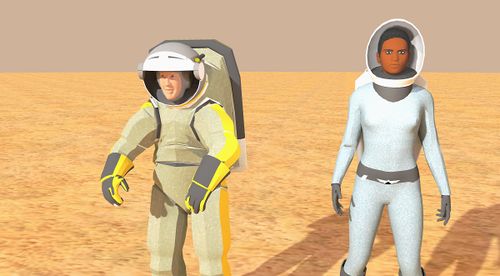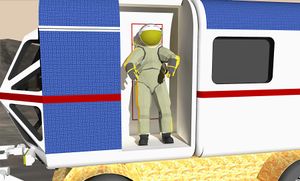EVA Suit
Since the atmospheric pressure on Mars is near vacuum, the settlers will need Space Suits for external operations, such as EVA or surface exploration. Certain areas in the settlements may also be kept at low pressure and require pressure suits. During some periods of the transit to Mars, notably take off and landing, it may be required to wear pressure suits in case of accidental loss of pressure.
Suit types
EVA suits
This suit provides protection from vacuum, temperature and radiation. It includes telecommunications and autonomous life support.
- Life support
- Air pressure: Most space suit designs use a design pressure of 4-5 psi, or about 1/3 of normal atmospheric pressure. They use an atmosphere enriched in oxygen, or pure oxygen, to provide sufficient oxygen to the astronauts. When changing from normal atmosphere to the lower pressure of the space suit, an adaptation time of 3/4 hours to one hour (sometimes much more) is required to avoid the risk of decompression sickness (the bends).
- Temperature control: EVA suits require cooling to evacuate the heat from the astronauts. Cooling may be done through evaporator plates or through radiators.
- CO2 management: Respiration will consume oxygen and produce CO2. CO2 may be absorbed chemically, or recycled in future advanced suits.
- Water handling: respiration as well as sweating produce water vapor, that can be condensed and stored, or used for cooling.
- Human waste management: Human wastes such as urine and feces have been handled up till now using maximum absorbency garments, i.e. diapers.
- VOCs: Volatile organic compounds produced by the human body can be absorbed chemically using activated charcoal filters.
- Dust protection: Martian dust may not be as as abrasive as Moon dust, but may be chemically active.
- Radiation protection: Suit must protect against UV, that are intense on the Martian surface. Some protection from ambient radiation is useful. Suits will not be able to protect against solar storms, so added shelters will be needed or protocols that demand astronauts reach safety areas in case of solar storms.
Pressure suits
These would be similar to the suits worn by astronauts during launch, or high altitude pilots. Services such as cooling, air, communications and power would be done through an umbilical connection, to simplify the design and reduce the mass of the suit. These normally operate within a pressurized atmosphere, but offer safety in case of accidental decompression.
Emergency pressure suits
These might be simplified versions of pressure suits, designed to be worn in case of accidental pressure loss in part of an habitat. Their main purpose would be to allow occupants to reach areas of safety through pressurized air locks in the habitats. Proper habitat design, in particular dividing habitats into sectors each provided with independent life support systems and connected by airlocks might make such suits redundant. Designing habitats to be 'blowout' resistant would also mitigate the need for this type of pressure suit. Habitats do not need to be entirely leakproof. They just need to be designed so that people can leave them faster than the time required for significant decompression.
Design elements
Pre-breathing period
If the suit is not at the same pressure as the habitat or vehicle that the astronaut is leaving, a pre-breathing period, or adaptation phase, is required. To adapt to this low pressure and avoid the risk of nitrogen narcosis an adaptation period is required. This requires the person who will be executing the EVA to breath pure oxygen for a few hours to purge their body of nitrogen, or to reside for a long period in a gradually lowered atmospheric pressure. This is time consuming and not practical if an emergency EVA were to be carried out.
- In the US space shuttle, cabin pressure was reduced from normal atmospheric to 70kPa (equivalent to an altitude of about 3000m) for 24 hours before EVA, and after donning the suit, a pre-breathing period of 45 minutes on pure oxygen before decompressing to the EMU working pressure of 30kPa.
- In the ISS there is no cabin pressure reduction, instead a 4 hour oxygen pre-breathe at normal cabin pressure is used to desaturate nitrogen to an acceptable level.
- US studies show that a rapid decompression from 101kPa to 55kPa has an acceptable risk, and Russian studies show that direct decompression from 101kPa to 40kPa after 30 minutes of oxygen pre-breathing, roughly the time required for pre-EVA suit checks, is acceptable.
Suit entry
- The Russian Orlan spacesuit is entered through the rear, with the backpack acting as a door. The Russian system can be entered in only five minutes, and with one seal is considerably safer as well.The rear entry suit can be used with a suitport. This can reduce contamination of the habitat by preventing any ingress of exterior dust.
- The American EMU has various seals at the waist, the helmet, the gloves, the boots, etc, each part being donned and then connected to each other. However, there are American designs for rear entry suits.
Suit shells
- All spacesuits used to date have been pressurized well bellow atmospheric pressure. Despite this, it is still difficult to move in EVA suits, since the pressure is still in the range of a few tonnes per m2 (40 to 50 kPa, 0r 5 psi) , and creates large forces on suit joints.
- The Mark III suit was an effort to develop a suit operating at 8 psi. This would reduce the prebreathing time required to practically 0.
- An alternative could be a skintight suit, the Mechanical Counterpressure suit, like the biosuit [1]. However, these suits are difficult to enter and exit. At this time, they are also planned to use a pressure of 4-5 psi, and therefore they do not reduce the adaptation time or solve the emergency exit issue. They also have significant issues with gloves, that have proven hard to design. Researchers at MIT are working on a spandex and nylon BioSuit to be used in such a situation. The torso would be pressurized to about 30 kPa while the limbs would be sheathed in thinner material allowing for increased dexterity and decreased weight from the current model. [1]
- Rigid suits at full atmospheric pressure, such as the American AX-5 have also been researched, notably to compare them with the mark III suits[2].
- Following the Artemis project development new spacesuits have been designed for NASA. These are hybrid models, with a hard central shell and soft limbs. The AxEMU is a rear entry suit, with evaporative cooling, 4.3 to 8.2 psi operating pressure (so practically no prebreathing at the highest value) a maximum EVA time of 9 hours and a mass of about 180 kg (over 400 pounds). [3]
- SpaceX has developed a EVA suit and tested it in the Polaris Dawn mission (2024). It operates at 5.1 psi, and is supported by an umbilical. Details are still scarce. This is probably not the final design, as SpaceX is likely to redesign over the next few years.
Helmets
Gloves
External Link
- ↑ 1.0 1.1 MIT, Dr. Dava Newman Building the Future Spacesuit , https://www.nasa.gov/pdf/617047main_45s_building_future_spacesuit.pdf.
- ↑ https://ttu-ir.tdl.org/server/api/core/bitstreams/6067bb34-2131-46ab-bac4-e13933a8b1e4/content
- ↑ https://oig.nasa.gov/wp-content/uploads/2024/02/IG-21-025.pdf








